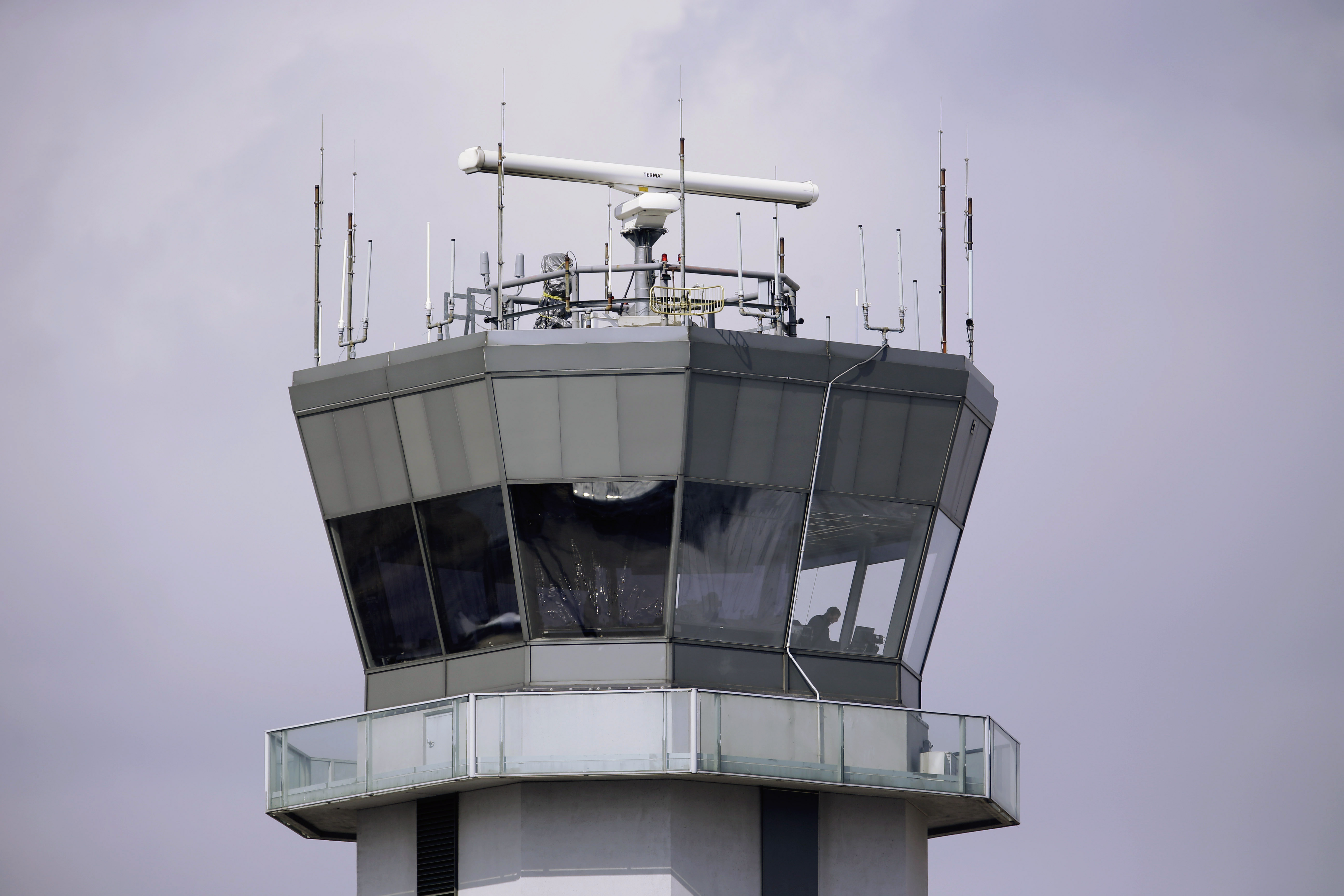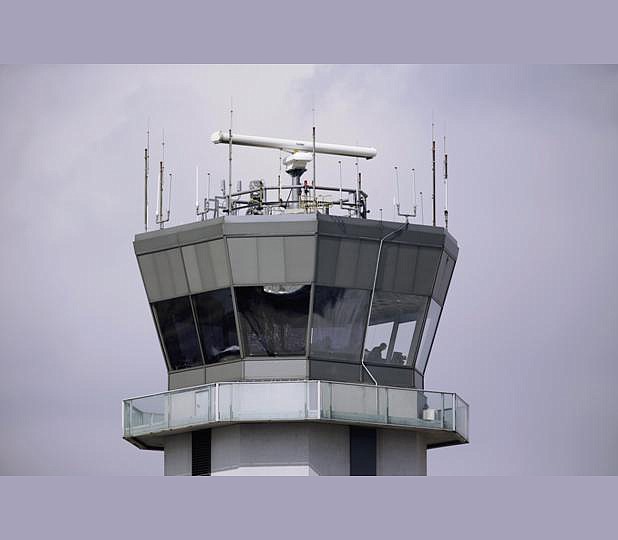Air traffic tower closures will strip safety net
Saturday, March 16, 2013
 The air traffic control tower stands over Chicago's Midway International Airport. Looming federal budget cuts could mean the closure of nearly 240 air traffic control towers at small airports across the country, stripping away an extra layer of safety during takeoffs and landings and leaving many pilots to manage the most critical stages of flight on their own. In addition, overnight shifts could be eliminated at 72 control facilities, including much larger airports such as Midway, which sees an average of 50 overnight flights, nearly all of them operated by Southwest and Delta.
The air traffic control tower stands over Chicago's Midway International Airport. Looming federal budget cuts could mean the closure of nearly 240 air traffic control towers at small airports across the country, stripping away an extra layer of safety during takeoffs and landings and leaving many pilots to manage the most critical stages of flight on their own. In addition, overnight shifts could be eliminated at 72 control facilities, including much larger airports such as Midway, which sees an average of 50 overnight flights, nearly all of them operated by Southwest and Delta.CHICAGO - The planned shutdown of nearly 240 air traffic control towers across the country under federal budget cuts will strip away an extra layer of safety during takeoffs and landings, leaving pilots to manage the most critical stages of flight on their own.
The towers slated to close are at smaller airports with lighter traffic, and all pilots are trained to land without help by communicating among themselves on a common radio frequency. But airport directors and pilots say there is little doubt the removal of that second pair of eyes on the ground increases risk and will slow the progress that has made the U.S. air system the safest in the world.
It's not just private pilots in small planes who stand to be affected. Many of the airports in question are serviced by major airlines, and the cuts could also leave towers unmanned during overnight hours at some big-city airports such as Chicago's Midway and General Mitchell Airport in Milwaukee. The plans have prompted airlines to review whether the changes might pose problems for commercial service that could mean canceling or rescheduling flights.
Without the help of controllers, risk "goes up exponentially," said Mark Hanna, director of the Abraham Lincoln Capital Airport in Springfield, Ill., which could see its tower close.
As part of the spending cuts that went into effect this month, the Federal Aviation Administration is being forced to trim $637 million for the rest of the fiscal year that ends Sept. 30. The agency said it had no choice but to subject most of its 47,000 employees, including tower controllers, to periodic furloughs.
Representatives of the FAA declined to discuss the effect of the cuts with The Associated Press. In two recent speeches and testimony before Congress, FAA Administrator Michael Huerta stressed that safety remained the agency's top priority. But many in the aviation sector are frustrated that the political brinkmanship in Washington has affected such a sensitive area of aviation.
Jim Montman, manager of the Santa Fe Municipal Airport, which is on the list for tower closures, said the absence of controllers raises the risk of midair collisions "or some sort of incident where somebody lands on the wrong runway. ... That critical link is gone."
Hundreds of small airports around the country routinely operate without controllers, using procedures in place since the earliest days of aviation. Pilots are trained to watch for other aircraft and announce their position over the radio during approaches, landings and takeoffs.
But past crashes, however rare, have exposed weaknesses in that system.
On Nov. 19, 1996, a 19-seat United Express flight landing in Quincy, Ill., collided with another twin-engine turboprop that was taking off. They slammed into each other at the intersection of two runways, killing all 14 people aboard the two planes.
The National Transportation Safety Board concluded the probable cause was a failure of the pilots in the outbound flight to monitor the radio frequency for air traffic and to properly scan for other planes.
"If a tower was there, it's highly likely that that accident would have been prevented," said Hanna, who became director of the Quincy airport about two years after the crash and before moving to the job in Springfield.
The 238 air traffic control facilities that could be closed were chosen because they are at airports with fewer than 150,000 flight operations per year. They are located in nearly every state.
The first round of closures is expected to target 173 of those towers that are run by third-party contractors, rather than FAA staff. That process could start early next month.
Those airports had until Wednesday to put forward arguments for why their towers should stay open, but the bar is high and few are thought to be likely to escape the cuts. A final decision on the list is set for Monday.
The airports can choose to pick up the cost to keep their towers open, but few are expected to be able to afford that.
Beyond the airfields, some mayors are concerned about the impact on tourism if tower closures lead to the loss of passenger service. And there are worries of other effects, including whether medical helicopter pilots might stop using airports without tower controllers.
Rep. Aaron Schock, an Illinois Republican whose district includes the Springfield airport, said the FAA's operational budget has grown about 40 percent over the past decade and there's no reason it can't operate safely under the automatic spending cuts, known as sequestration.
"Any action by the Obama administration that does jeopardize safety is more evidence that the White House is implementing the sequester in ways to only score political points," Schock said.
Robert Poole, an aviation expert at the Reason Foundation think tank, said the effect could be minimal for some small airports that have been overdeveloped as a result of politicians bringing money home from Washington.
In addition to round-the-clock tower closures, overnight shifts could be eliminated at 72 control facilities, including at much larger airports such as Midway, which sees an average of 50 flights daily between 10 p.m. and 7 a.m., nearly all of them passenger flights operated by carriers that include Southwest and Delta.
That raises the possibility that full-size jetliners could be landing there without any help from controllers.
Airlines have yet to say whether they will continue offering service to airports that lose tower staff.
"It's premature to discuss flight cancellations, as the earliest any furloughs would occur is April 7," said Katie Connell, spokeswoman for the industry group Airlines for America. "We are working with the FAA to minimize any impact to passengers and shippers."
Chicago pilot Robert McKenzie, who has a commercial license but primarily flies a small Cessna, has a lot of experience landing at smaller airports without control towers.
Doing so involves a lot more concentration, he said. Pilots have to watch for other aircraft, take note of weather conditions, look for debris on runways and make calls over the radio - all while operating their own plane.
Pilots have a very good track record of doing that safely. "But it never hurts to have somebody else out there helping you watch," McKenzie said. "It's a nice safety net to have."
McKenzie, a lawyer specializing in aviation matters, says the loss of towers is of concern to the Illinois Pilots Association, where he sits on the board of directors.
Most troubling, he said, would be the loss of towers at airports such as Springfield and Santa Fe, which are used by a mix of small private planes and larger passenger aircraft that often converge on airfields at different speeds and using different procedures. Controllers keep those planes safely separated and sequenced for landings.
Tower controllers also play a big role in keeping aircraft from taxiing across active runways, something that has been a key FAA focus for years.
"When you're at an uncontrolled field, avoiding that problem is entirely dependent on other pilots not making mistakes," McKenzie said. "There's nobody there as a backup."
